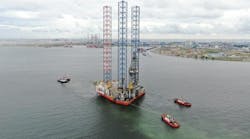TSF optimizing riser by varying wall thickness
The new generation of semisubmersible mobile offshore drilling units introduced by Transocean Sedco Forex (TSF) will feature deepwater riser systems with optimized wall thicknesses throughout the string. Alternating the wall thickness to meet design conditions reduces the steel weight of the riser. This means less syntactic foam buoyancy required to support the riser in water and a reduction in the deckload for the vessel. The savings resulted from the use of new analytical software developed by a joint industry project the contractor was involved in.
Transocean Sedco Forex's new generation of rigs is designed to operate in moderate environments such as the Gulf of Mexico, according to John Kozicz, Technical Manager for the firm's Sedco Express Project. The company used a combination of software products to analyze the stresses that moderate environments place on the riser string. The new design was developed in reverse. This means the company started with a standard uniform wall thickness, then looked at what improved the design. All the alternatives considered were standard mill-sized tubes, and the final product was designed in accordance with API guidelines.
While rigs designed to drill in the Gulf of Mexico face a moderate environment, Kozicz points out that moderate is not the same thing as benign. The Gulf of Mexico plays host to hurricanes, gales, and strong currents. What makes the environment moderate is the absence of strong waves such as those experienced West of the Shetland Islands, in the North Sea, or offshore eastern Canada. In addition to the harsh weather in the West of Shetlands, the area has very complex currents. The Gulf of Mexico also has significant currents, especially in deepwater. The loop and eddy currents in the Gulf have caused vortex induced vibrations in risers and other hanging lines, resulting in some downtime during drilling and completion operations.
Two areas of the riser string, the upper interval and the lower interval above the blowout preventer stack, receive the heaviest stress loads. For ultra-deepwater, these areas are impacted by storm disconnect and hangoff at the surface and internal pressure from high mud weights at the lower flex joint.
The software program used by Transocean Sedco Forex in designing the new riser system predicted loading conditions for every joint in the string. The program calculated stresses at a number of points along each joint. Kozicz said that in addition to varying the riser wall thickness, it is possible for the designer to plug in a number of heavier joints at the bottom of the string and have the program calculate how the riser string would perform.
A riser with thinner walls will be less costly to manufacture, but Kozicz said the real savings is in minimizing the rig deckload. An 8,000-ft riser string weighs about 5.5 million lb. The optimized design saves 10-15% of this weight, since the tubulars and buoyancy are lighter. The buoyancy, in particular, adds weight as well as cost to the string. Basically, the weight of the riser is doubled when buoyancy is added, and the buoyancy can cost as much or more than the riser itself.
"You are carrying your riser with you (on the rig) everywhere you go, so it's basically dead weight," Kozicz said. By designing this riser for the Gulf of Mexico, Kozicz said the company can easily operate this riser in any moderate environment, including West Africa, Brazil, and Southeast Asia, on a year-round basis.
The system Transocean Sedco Forex settled on is a tapered string with heavier riser walls at top and bottom and thinner walled riser in the middle. He said the design was limited to one or two size changes, so it would not be too difficult for the crew to manage logistically and run.
Åsgard receives world's largest arches
Statoil's Asgard field in the Norwegian sector of the North Sea will feature the world's largest mid-water arches. Statoil contracted for the design and construction of the two mid water arches, which will support the water column weight of the field's production risers and umbilicals. Manufactured by Umoe Anchor Contracting, the arches will support 16.6-in. and 14-in. risers. Stolt Offshore will install the arches in 300 meters water depth, which is a world's record depth for such a riser support system. This installation will follow a concept also developed by UAC. According to the manufacturer, the riser supporting structures are made of glass fiber reinforced plastic, weigh 50 tons, and have a wingspan of around 15 meters. This design represents a breakthrough for a heavily loaded subsea structure in GRP. The buoy tanks are designed so that only 200 kg of steel are needed to provide one ton of net buoyancy at 220 meters water depth.
The net buoyancy of the two systems will be 400 tons and 200 tons. These will be adjustable to accommodate the number of installed risers. The systems will be installed using pre-installed tethers, pulled down to pre-installed suction-embedded anchors. A remotely operated vehicle will connect the tethers to the anchors. The steel rope tethers are protected from corrosion by plastic rope, according to Umoe.
This chart graphs the relationship between top tension and water depth for riser systems with steel choke and kill lines, and those with new composite choke and kill lines. ABB Vetco Gray developed the graph to show the savings for varying water depths. The composites save weight, which means greater depth range for the same top tension on a deepwater riser. In some cases, it is possible the weight savings would allow older, smaller MODUs to make the jump to deepwater drilling, without the need for an upgrade. ABB Vetco Gray and other companies are in the final stages of introducing systems with composite choke and kill lines, which can be integrated with new riser systems or retrofitted.




